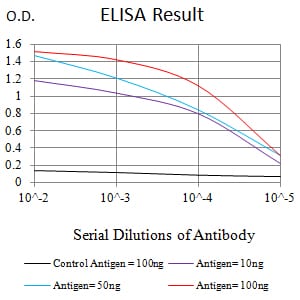





| WB | 1/500 - 1/2000 | Human,Mouse,Rat |
| IF | 咨询技术 | Human,Mouse,Rat |
| IHC | 1/200 - 1/1000 | Human,Mouse,Rat |
| ICC | 1/500 - 1/2000 | Human,Mouse,Rat |
| FCM | 1/200 - 1/400 | Human,Mouse,Rat |
| Elisa | 1/10000 | Human,Mouse,Rat |
| Entrez GeneID | 1266 |
| clone | 5E4E4 |
| WB Predicted band size | 36.4kDa |
| Host/Isotype | Mouse IgG1 |
| Antibody Type | Primary antibody |
| Storage | Store at 4°C short term. Aliquot and store at -20°C long term. Avoid freeze/thaw cycles. |
| Species Reactivity | Human |
| Immunogen | Purified recombinant fragment of human CNN3 (AA: 26-130) expressed in E. Coli. |
| Formulation | Purified antibody in PBS with 0.05% sodium azide |
+ +
以下是关于CNN3抗体的参考文献示例(仅供参考,具体文献需通过学术数据库核实):
---
1. **文献名称**:*"Calponin 3 (CNN3) as a Novel Biomarker in Gastric Cancer: Immunohistochemical Analysis Using a Specific Monoclonal Antibody"*
**作者**:Zhang L, et al.
**摘要**:本研究开发了一种针对CNN3蛋白的单克隆抗体,并通过免疫组化分析发现CNN3在胃癌组织中的高表达与肿瘤侵袭和转移显著相关,提示其可能作为预后标志物。
2. **文献名称**:*"Functional Characterization of CNN3 in Smooth Muscle Cell Contraction via Antibody-Mediated Knockdown"*
**作者**:Tanaka K, et al.
**摘要**:利用特异性CNN3抗体进行功能研究,发现抑制CNN3表达可显著降低血管平滑肌细胞的收缩能力,表明其在调节细胞骨架动力学中的关键作用。
3. **文献名称**:*"Development and Validation of a Polyclonal Antibody for Detecting CNN3 in Human Tissue Samples"*
**作者**:Wang Y, et al.
**摘要**:报道了一种高亲和力的CNN3多克隆抗体的制备,并通过Western blot和免疫荧光验证其在多种组织中的特异性,为后续疾病机制研究提供工具。
4. **文献名称**:*"CNN3 Expression Correlates with Poor Prognosis in Triple-Negative Breast Cancer: Insights from Antibody-Based Proteomic Profiling"*
**作者**:Gupta S, et al.
**摘要**:通过抗CNN3抗体对三阴性乳腺癌样本进行蛋白表达分析,发现CNN3高表达与患者生存率下降相关,提示其作为潜在治疗靶点。
---
**提示**:以上为示例文献,实际研究中请通过PubMed、Web of Science等平台以“CNN3 antibody”“Calponin 3”等关键词检索最新文献,并关注抗体应用的具体场景(如疾病模型、分子机制等)。
CNN3 antibody targets calponin-3 (CNN3), a member of the calponin family of actin-binding proteins involved in cytoskeletal regulation. Calponin-3. encoded by the *CNN3* gene, is expressed in smooth muscle cells, fibroblasts, and certain non-muscle tissues, where it modulates cell contraction, motility, and mechanotransduction. Unlike its isoforms CNN1 and CNN2. CNN3 exhibits broader tissue distribution and dynamic roles in cellular processes such as differentiation, adhesion, and wound healing. It interacts with actin filaments, myosin, and other cytoskeletal components, influencing cell morphology and mechanical properties.
Antibodies against CNN3 are essential tools for studying its expression, localization, and function in physiological and pathological contexts. They are widely used in techniques like Western blotting, immunohistochemistry (IHC), and immunofluorescence (IF) to investigate CNN3’s involvement in diseases such as cancer (e.g., tumor metastasis), cardiovascular disorders, and fibrotic conditions. Researchers also utilize CNN3 antibodies to explore its regulatory mechanisms in smooth muscle plasticity and tissue remodeling. Commercial CNN3 antibodies are typically raised in rabbits or mice, with specificity validated via knockout controls or siRNA silencing. Variations in antibody performance may arise due to post-translational modifications or tissue-specific isoforms, necessitating careful validation for experimental accuracy.
×